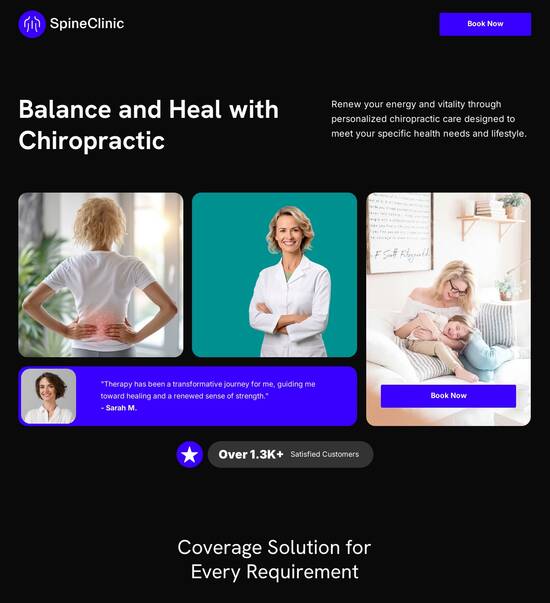
React.js optimized our clients page template
Explore Similar TemplatesAbout template
Supercharge your our clients page with React.js for outstanding performance! Learn more today.
Recommended templates

Easy to build without coding
With the intuitive drag-and-drop builder, anyone on your team can create high-converting pages without any knowledge of code or design. Make enhancements to your landing page with custom widgets using Javascript, HTML/CSS, or third-party scripts.

Multiple layouts for any industry and goal
Select from 500+ landing page layouts built to boost conversions across industry-specific scenarios. Customize them by adjusting fonts, adding images, and generating on-brand content with the AI assistant. Quickly scale with Instablocks® and Global Blocks that you can save, reuse, and update globally.

Loads fast and looks polished on any device
Every template is responsive, which means they present professionally on any device and load blazingly fast with our Thor Render Engine. You can also power them up with Google AMP technology to deliver an unparalleled mobile experience and drive higher conversions.

Robust analytics & experimentation
Get real-time updates and reporting across all your devices, showing the number of visitors, conversions, cost-per-visitor, and cost-per-lead. Launch AI-powered experiments, run A/B tests, and use heatmaps to analyze user behavior, then optimize your landing page to maximize conversions.







Easy to build without coding
With the intuitive drag-and-drop builder, anyone on your team can create high-converting pages without any knowledge of code or design. Make enhancements to your landing page with custom widgets using Javascript, HTML/CSS, or third-party scripts.
Multiple layouts for any industry and goal
Select from 500+ landing page layouts built to boost conversions across industry-specific scenarios. Customize them by adjusting fonts, adding images, and generating on-brand content with the AI assistant. Quickly scale with Instablocks® and Global Blocks that you can save, reuse, and update globally.
Loads fast and looks polished on any device
Every template is responsive, which means they present professionally on any device and load blazingly fast with our Thor Render Engine.
Robust analytics & experimentation
Get real-time updates and reporting across all your devices, showing the number of visitors, conversions, cost-per-visitor, and cost-per-lead. Launch AI-powered experiments, run A/B tests, and use heatmaps to analyze user behavior, then optimize your landing page to maximize conversions.
All the features you need to build lead-generating landing pages
Explore more featuresLearn how to build top-performing landing pages for any goal
FAQs
Leading the way in building high-performing landing pages





An introduction to Instapage: the most powerful landing page platform
Instapage is a robust landing page and conversion rate optimization (CRO) platform designed to empower marketers across various sectors, including tech and education, to enhance their digital marketing campaigns. By providing an all-in-one solution for creating, optimizing, and personalizing landing pages, Instapage enables users to maximize their return on investment (ROI) consistently. Understanding how to harness its capabilities effectively can significantly impact your campaign outcomes.
Benefits of using Instapage for landing page creation
Instapage offers a range of benefits that cater specifically to the needs of marketers in business services, financial services, and government sectors. By leveraging its advanced features, organizations can streamline their marketing efforts. Here’s how:
- Access to over 100 high-converting templates allows users to quickly deploy campaigns without starting from scratch.
- Advanced analytics and heat map features provide insights into user behavior, assisting in optimizing campaigns for better conversion rates.
- The platform’s collaborative tools facilitate immediate feedback and real-time edits, enhancing team efficiency.
Step 1: Designing landing pages with ease
Creating landing pages on Instapage is straightforward thanks to its user-friendly interface. Here are the main steps to get started:
- Choose from a library of templates tailored to your industry. This ensures that your design resonates with your target audience.
- Use the drag-and-drop builder for customization. Easily add elements like forms and CTA buttons to enhance user interaction.
- Preview and optimize your design for mobile, ensuring that your pages look great on all devices.
Step 2: Optimizing your pages for maximum results
Optimization is key to driving conversions. Here’s how to effectively utilize Instapage’s built-in tools:
- Implement A/B testing to compare different landing page versions. This allows you to understand which variations perform better.
- Utilize heatmaps to track visitor engagement and refine your layout based on actual user interactions.
- Analyze performance metrics regularly with the analytics dashboard to make informed decisions for campaign adjustments.
Step 3: Personalizing user experiences
Personalization can significantly enhance user engagement. Instapage offers features to help tailor experiences precisely:
- Dynamic text replacement allows you to customize content based on traffic sources, making your messaging more relevant.
- Use AdMaps to align specific advertisements with dedicated landing pages, improving the user journey.
- Track audience-level metrics to see how different segments interact with your content and optimize accordingly.
By following these steps and leveraging Instapage’s comprehensive features, marketers can effectively enhance their online campaigns and drive improved results.
Get started with Instapage today to transform your digital marketing strategy and take charge of your campaign success!
How ReactJS Optimized Our Clients' Page Template
The evolution of landing page design: From static to dynamic
Landing page design has undergone significant transformations over the years from static, text-heavy pages to highly interactive and dynamic experiences. Users today expect an engaging and seamless browsing experience. This shift is driven by the increasing use of mobile devices and a general demand for faster interactions. Today's visitors want to find their information quickly and interact with content intuitively. Furthermore, users appreciate pages that respond promptly to their actions, which has made speed and responsiveness crucial elements in landing page design.
Users expect real-time interactions and a faster response to their inputs.
Dynamic visuals and content updates enhance user engagement.
Mobile optimization is not just a nice-to-have; it is essential for user retention.
With evolving user expectations, traditional page design methods fall short. This has led to the rise of frameworks like ReactJS, which address these new demands effectively. ReactJS offers a modern approach to building user interfaces with a host of advantages.
Component-based architecture allows for reusable code, which simplifies maintenance.
A fast rendering process, thanks to its virtual DOM, enhances speed.
A large community and many libraries extend development capabilities.
Search Engine Optimization (SEO) benefits for better visibility.
Statistically, React is favored by many developers, with surveys showing that over 70% of web developers prefer using it for building interactive web applications. Thus, the case for ReactJS becomes compelling as it aligns closely with modern design expectations.
Understanding ReactJS: The core features driving optimization
At the heart of ReactJS lies a powerful architecture that enhances both the development process and user experience. The component-based architecture allows teams to break down the user interface into independent, reusable pieces, or components. This modular approach means that development becomes less cumbersome, facilitating easier updates and maintenance. Teams working collaboratively can efficiently create and iterate on templates without stepping on each other's toes.
Moreover, React utilizes a virtual DOM, which significantly optimizes performance. Instead of directly manipulating the browser's DOM, React first alters the virtual representation and only updates the real DOM when necessary. This process enhances page load times, providing a smoother user experience.
Faster rendering processes through fewer direct DOM updates.
Efficient reconciliation processes reduce render times.
Better resource management leads to lower load times overall.
Additionally, React's JavaScript library offers flexibility and customization in building landing page components, enabling developers to adapt various functionalities to fit their needs. Compatibility with powerful libraries, such as Redux and MobX, allows teams to enhance templates further, adding sophisticated features like state management or even server-side rendering capabilities.
The power of optimized page templates in ReactJS
One of the standout features of ReactJS is the availability of prebuilt templates that streamline the development process. These ready-to-use designs save time and effort while retaining an appealing aesthetic. They come equipped with essential features, such as mobile responsiveness and A/B testing capabilities, enabling marketers to gather insights quickly.
Quick setup allows marketers to focus on content rather than design.
Prebuilt templates often come with analytics integrations for instant feedback.
Tweakable components enable brands to maintain uniqueness in their offerings.
In case studies showcasing successful implementations of ReactJS templates, clients reported increased engagement and conversion rates. For instance, a marketing agency utilizing ReactJS templates saw a 40% boost in conversion rates due to improved page loading times and personalized content delivery.
Customizable components empower teams to maintain brand identity while employing optimized templates. Critical elements like headers, sidebars, and footers can be adjusted without compromising the HTML structure, ensuring consistent branding across all landing pages. A well-defined content strategy enables teams to align their messaging with user expectations.
Responsiveness is inherently built into ReactJS templates. They automatically adapt to various screen sizes, an essential feature for today’s multi-device users. Testing these templates involves strategies like utilizing emulators and browser developer tools to verify performance across different formats.
Conduct tests on multiple devices like tablets and smartphones.
Analyze how changes in orientation affect layout.
Ensure that all buttons and links remain accessible on smaller screens.
User experience: Elevating interaction with innovative features
ReactJS enhances user experience by allowing for dynamic content loading and real-time updates. This means that users can interact with forms, chatbots, and other elements without having to refresh the page, creating a smoother interaction flow. Such features foster engagement and encourage users to spend more time on the page, thus increasing the likelihood of conversion.
Instant feedback on form submissions enhances interaction.
Chatbot integrations provide 24/7 assistance without constant manual intervention.
Dynamic forms can update depending on user inputs for a personalized experience.
Furthermore, ReactJS provides teams a way to manage permissions and user roles effectively. Controlled access to specific components ensures that sensitive information remains secure, which is vital in projects involving community elements. This structured approach not only enhances security but also provides an organized workflow for team members.
Role-based access increases security by limiting visibility based on user roles.
Permissions can be easily managed through components and settings.
Community-driven projects benefit from well-defined contribution guidelines.
Iterative design is another area where React excels. Enhanced previews during development allow teams to visualize changes in real-time, which leads to timely feedback and adjustments. This results in a more polished product by the time it is launched, as developers can make incremental adjustments based on immediate visual responses.
Collaborative tools: Fostering innovation among teams
Collaboration is pivotal in today’s development environments, and ReactJS supports this through various tools and platforms. Communities of developers share best practices and innovations, allowing for collective growth and knowledge accumulation. Popular forums and platforms foster interaction and problem-solving within the community.
GitHub remains an essential tool for version control and collaboration.
Platforms like Figma enhance design sharing and review processes.
Slack channels provide instant communication among team members.
Implementing best practices within your ReactJS workflows is crucial for efficiency. Organizing regular code reviews and maintaining clear documentation can significantly boost team productivity. Some teams have had success by adhering to shared communication protocols that streamline discussions.
Clear naming conventions improve understanding among team members.
Regular check-ins keep all parties aligned on project progress.
Shared workflows help maintain focus on the overall goal while adapting to project changes.
The global nature of today's workforce means that teams often span multiple locations. ReactJS supports this cross-location development approach, enabling teams to collaborate seamlessly. One notable success story involved a company with teams in different countries working together to produce a single landing page project; the result was a cohesive and impactful landing page that met all stakeholder expectations.
Addressing common questions about ReactJS and template optimization
Organizations often wonder what makes reactive templates different from traditional templates. The primary distinction lies in how these templates render content and respond to user interactions. Reactive templates are intended for creating fluid interactions, whereas traditional templates may require page reloads or lead to sluggish performances.
Reactive templates prioritize user engagement and interactivity.
Performance optimization reduces loading times and enhances overall user satisfaction.
Dynamic updates keep content fresh and relevant for returning users.
Getting started with ReactJS for page optimization involves a few key steps. First, familiarize yourself with the basic principles of React and its ecosystem. Next, set up your development environment using Node.js and npm, which are essential for managing React packages efficiently. Lastly, explore essential libraries, such as React Router for navigation and Axios for API handling, to kickstart development.
Use Create React App for an easy setup.
Explore documentation and tutorials for best practices.
Engage with the community for support and collaboration.
Common issues in ReactJS page templates often relate to performance bottlenecks or component lifecycle mishaps. Understanding the lifecycle methods and how state management influences rendering can help mitigate these challenges. Access to community support resources can be invaluable for troubleshooting.
Use Chrome DevTools to analyze rendering performance.
Refer to community forums for shared solutions.
Regular updates can help mitigate bugs and inconsistencies.
Future trends: The evolving landscape of ReactJS in landing page design
As technology continues to advance, ReactJS will likely evolve in response to emerging trends, such as Server-Side Rendering (SSR) and JAMstack architecture. These technologies significantly enhance the overall experience and template optimization by improving load times and SEO performance.
SSR allows pre-rendering for faster access to content, which improves SEO.
JAMstack provides improved security and faster scalability.
Headless CMS solutions can be integrated for a more flexible content management approach.
User interaction trends in landing page design are also forecasted to evolve. For instance, AI-driven personalization tools are emerging that cater to user behavior in real-time, ensuring tailored experiences that resonate with individual needs.
Expect increases in automated A/B testing capabilities.
Integration with emerging technology such as Augmented Reality (AR) for novel interactions.
Further developments in accessibility features to create more inclusive designs.
As ReactJS continues to grow, community contributions are crucial for its development. Notable collectives are dedicated to enhancing templates for optimized landing pages, further pushing the boundaries of what React can achieve.
Real-world success stories: Transformations through ReactJS
Numerous clients have successfully optimized their web presence using ReactJS, leading to impressive results. One particularly striking case involved a tech startup that revamped its landing page using ReactJS templates. The streamlined development process and interactive features resulted in a conversion increase of over 50% within a couple of months of launching the new template.
Improved engagement led to longer session durations on the site.
Enhanced SEO capabilities resulted in higher search rankings.
More personalized user experiences increased overall customer satisfaction.
From the implementation process, several lessons emerged. First, establishing clear communication channels proved vital in avoiding project delays. Second, thorough testing ensured that the templates functioned optimally across different devices and scenarios.
Prioritize user testing to gather insights before a full-scale launch.
Individual components can ideally be worked on without dependency on the entire system.
Documentation is essential for long-term maintenance and onboarding new team members.
The scalability of ReactJS ensures that it can grow with evolving business needs. As new challenges arise, ReactJS will provide the foundation necessary for continued optimization through its versatile architecture and extensive community resources.
Ready to skyrocket conversions?
Supercharge your ad campaigns with high-performing landing pages
Get started














